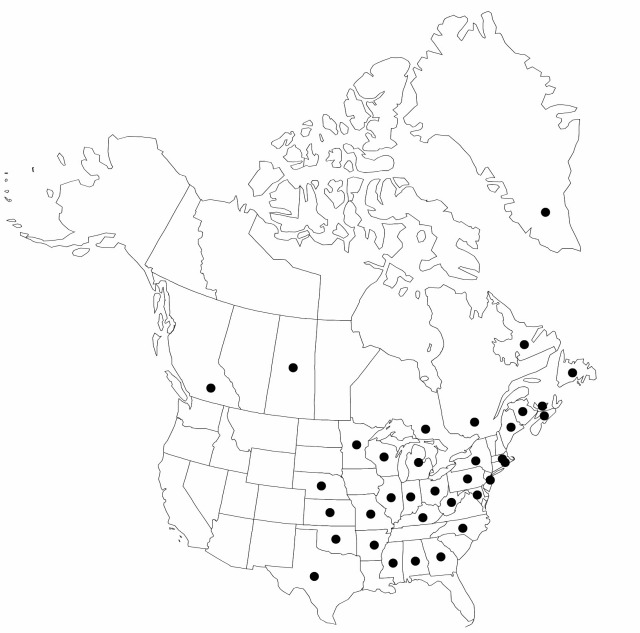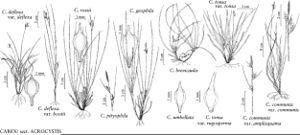Carex umbellata
Sp. Pl. 4(1): 290. 1805.
Plants densely cespitose; rhizomes ascending to erect, reddish-brown, 0–5 mm, stout. Culms 3–7.5 (–18) cm, scabrous distally; bases (remnants of old leaves) weakly to strongly fibrous. Leaf-blades pale green, greatly exceeding culms, 1–2.3 (–3.8) mm wide, herbaceous, glabrous abaxially, strongly scabrous to papillose adaxially. Inflorescences with both staminate and proximal spikes; peduncles of basal spikes erect, short-to-elongate, slender; peduncle of staminate spikes 0.7–5.2 (–12.3) mm; proximal nonbasal bracts scalelike, usually shorter than (occasionally equaling) inflorescences. Spikes: proximal pistillate spikes 2–5 (basal spikes 1–3); cauline spikes overlapping with staminate spikes, with (1–) 4–12 perigynia; staminate spikes 4.6–13 × 0.7–2.2 mm. Scales: pistillate scales reddish-brown with narrow white margins, ovate, 2.8–3.9 × 1.5–1.9 mm, equaling or exceeding perigynia, apex acute to acuminate; staminate scales ovate to lanceolate, 3.5–5.1 × 1.1–2.2 mm, apex obtuse to acute. Anthers 1.7–2.2 mm. Perigynia pale green to pale-brown, veinless, obovoid to globose, rarely ellipsoid, obtusely trigonous in cross-section, 2.2–3.2 × 1–1.4 mm; beak straight, pale green to pale-brown, strongly 2-edged, 0.4–1 mm, weakly ciliate-serrulate, apical teeth 0.1–0.2 mm. Stigmas 3. Achenes brown, ellipsoid, obtusely trigonous in cross-section, 1.4–1.7 × 1–1.3 mm. 2n = 30, 32.
Phenology: Fruiting mid Mar–mid Jul.
Habitat: Open, dry to mesic, circumneutral to calcareous, clayey, sandy, and rocky fields, pastures, tall-grass prairies, glades, ridges, slopes, bluffs, dunes, barrens, open deciduous and mixed woodlands, also on serpentine and basalt, often at edges of ant hills
Elevation: 90–300 m
Distribution

Greenland, B.C., N.B., Nfld. and Labr., N.S., Ont., P.E.I., Que., Sask., Ala., Ark., Ga., Ill., Ind., Kans., Ky., Maine, Md., Mass., Mich., Minn., Miss., Mo., Nebr., N.J., N.Y., N.C., Ohio, Okla., Pa., R.I., Tex., W.Va., Wis.
Discussion
Some botanists think Carex microrhyncha should be retained as a distinct species. A revision of the C. umbellata-C. tonsa complex may reveal distinctions; until that work is done, we prefer to combine C. microrhyncha with C. umbellata.
Selected References
None.
Lower Taxa
"shortened" is not a number.
